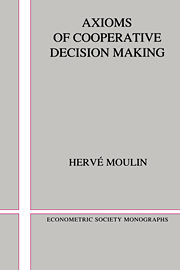1 - Egalitarianism versus utilitarianism
Published online by Cambridge University Press: 05 January 2013
Summary
Overview
Utilitarianism is a philosophical thesis two centuries old. It judges collective action on the basis of the utility levels enjoyed by the individual agents and of those levels only. This is literally justice by the ends rather than by the means. Welfarism is the name, coined by Amartya Sen, of the theoretical formulation of utilitarianism, especially useful in economic theory and other social sciences. Its axiomatic presentation, developed in the last three decades, is the subject of Chapters 2 and 3.
For the utilitarianist, social cooperation is good only inasmuch as it improves upon the welfare of individual members of society. The means of cooperation (social and legal institutions, such as private contracts and public firms) do not carry any ethical value; they are merely technical devices - some admittedly more efficient than others - to promote individual welfares. For instance, protecting certain rights - say, freedom of speech - is not a moral imperative; it should be enforced only if the agents derive enough utility from it.
This very dry social model rests entirely upon the concept of individual preferences determined by the agents “libre-arbitre” while deliberately ignoring all its mitigating factors (among them education and the shaping of individual opinion by the social environment, as well as kinship, friendship, or any specific interpersonal relation). Ever since Bentham, utilitarianists have been aware of these limitations. Yet, oversimplified as it is, the utilitarian model is easily applicable, and its "liberal" ideology has the force of simplicity. The philosophical debate on utilitarianism is still quite active (see, e.g., Sen and Williams [1982]).
- Type
- Chapter
- Information
- Axioms of Cooperative Decision Making , pp. 11 - 29Publisher: Cambridge University PressPrint publication year: 1988



